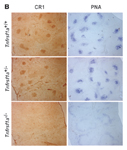|
|
| Symbol: |
Tnfrsf1atm1Blt |
| Name: |
tumor necrosis factor receptor superfamily, member 1a; targeted mutation 1, Horst Bluethmann |
| MGI ID: |
MGI:1861040 |
| Synonyms: |
p55-, p55TNFR-, R1KO, Rothe Tnfrsf1a-, Tnfr10, TnfRI-, TNFRp55 |
| Gene: |
Tnfrsf1a Location: Chr6:125326686-125339446 bp, + strand Genetic Position: Chr6, 59.32 cM
|
| Alliance: |
Tnfrsf1atm1Blt page
|
|
Germinal centers and follicular dendritic cell networks are absent in Tnfrsf1atm1Blt/Tnfrsf1atm1Blt mice immunized with sheep red blood cells
Show the 1 phenotype image(s) involving this allele.
|

|
|
| Germline Transmission: |
Earliest citation of germline transmission:
J:14424
|
| Parent Cell Line: |
E14 (ES Cell)
|
| Strain of Origin: |
129P2/OlaHsd
|
|
| Allele Type: |
|
Targeted (Null/knockout) |
| Mutations: |
|
Insertion, Intragenic deletion
|
| |
|
Mutation details: A neomycin cassette was used to replace the exons 2, 3, and a portion of 4. The affected exons code for the cysteine-rich domains I and II that are essential for binding of the ligand.
(J:14424, J:92470)
|
| Inheritance: |
|
Recessive |
|
|
View phenotypes and curated references for all genotypes (concatenated display).
|
|
|
|
|
|
|
|
Mice homozygous for this allele lack the type 1 receptor (J:14424). Mouse embryos produce TNF and its receptors (J:16646), and the evidence suggests that TNF is involved in important physiological functions. However, homozygous mutant mice develop normally and are fertile with normal litter sizes (J:21202). These mice resist toxicity of low dosage lipopolysaccharide treatment, mediated by the type 1 receptor, although they remain sensitive to high lipopolysaccharide doses. They are also more sensitive to infection with Listeria monocytogenes (J:14424). Cytotoxic T lymphocyte induction by TNF via Tnfrsf1a is not essential to the response to viral infection, homozygous mutant mice being capable of controlling viral infection normally. It is, of course, possible that the essential receptor molecule in these reactions is TNFRSF1B, or that TNFRSF1B can substitute for TNFRSF1A in the absence of the latter (J:21202). A differential response of mutant homozygotes to activation by mouse TNF, which can activate either TNFRSF1A or TNFRSF1B, and human TNF, which is selectively interactive with TNFRSF1A only, suggests that substitution can take place in some circumstances (J:21648). On the other hand, TNF inhibition of Csh2 expression is mediated through the TNFRSF1A, but not the TNFRSF1B, receptor (J:19617).
|
| Original: |
J:14424 Rothe J, et al., Mice lacking the tumour necrosis factor receptor 1 are resistant to TNF-mediated toxicity but highly susceptible to infection by Listeria monocytogenes. Nature. 1993 Aug 26;364(6440):798-802 |
| All: |
143 reference(s) |
|
 Analysis Tools
Analysis Tools





